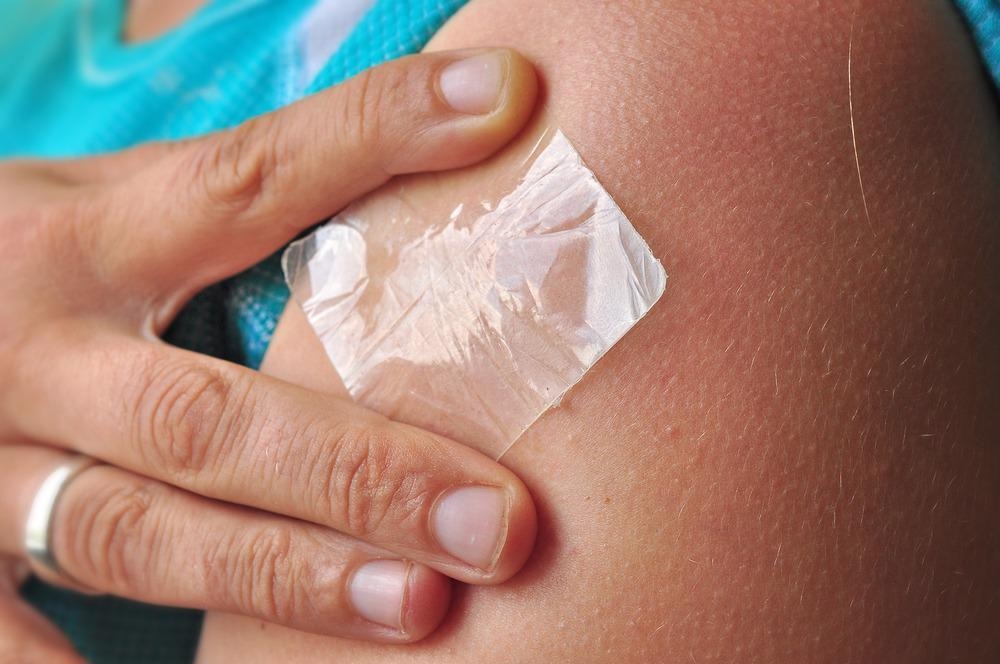The challenge of transdermal delivery of solid nanoparticles remains a major obstacle; however, with novel research published within the Journal of Controlled Release, a solution may be imminent. Researchers have developed a non-invasive strategy for transdermal delivery of mesoporous silica nanoparticles for enhanced skin penetration.

Study: Noninvasive transdermal delivery of mesoporous silica nanoparticles using deep eutectic solvent. Image Credit: Meryll/Shutterstock.com
Why is Non-Invasive Transdermal Delivery Necessary?
Transdermal drug delivery systems (TDDS) have the ability to be a route of administration that could treat both local diseases as well as systemic due to the penetration into the blood circulation.
This administration approach comprises applying a drug through the skin, such as an adhesive patch, and is seen as quite desirable due to being pain-free compared to the adverse effects experienced, such as pain and soreness from standard drug administration.
The benefits of transdermal delivery over standard drug administration methods such as hypodermic needles include avoidance of first-pass hepatic metabolism as well as increasing patient compliance.
With controlled drug release and reduced side effects, ease in use, accessibility to immune cells abundantly found in the skin, as well as the increased availability of a drug, this pain-free approach is highly preferable.
However, with the stratum corneum being a barrier for transdermal delivery, the advancement in nanotechnology has allowed for the potential of overcoming this skin barrier that may improve the stability of drugs.
Overcoming Transdermal Delivery Challenges Via Nanotechnology
Previous research into transdermal drug delivery has comprised of the use of lipid nano-vehicles, including microemulsion, liposomes, nanoemulsion and ethosomes.
These nanoparticles have demonstrated enhanced permeation as a result of high load capacity as well as an affinity towards lipid structures within the skin.
Additionally, research into polymeric nanoparticles, such as micelles and nano hydrogels, has been investigated and strategized for transcutaneous immunization for vaccine use and treating skin diseases such as melanoma and infection.
However, the transportation of large drug molecules or proteins across the skin's stratum corneum barrier would require technologies such as microneedles, laser ablation, and iontophoresis. These techniques have not always been thought of as easily translatable for clinical use for mass populations.
To overcome limitations, innovative researchers have utilized a promising strategy for a transdermal drug delivery system (TDDS) which may provide a wider range of options for this desirable administration route.
Mesoporous Silica Nanoparticles
Mesoporous silica nanoparticles (MSNs) are inorganic nanocarriers that have grown traction over recent years due to their remarkable in vivo efficacy when identifying or treating a range of diseases.
The use of MSNs as a delivery reagent has been a revered approach with beneficial characteristics of silica, including chemical properties and thermal stability. Additionally, its unique mesoporous structure enables effective loading of drugs and controlled release into the target areas.
With the added advantage of modifiable mesoporous properties such as pore size, high drug loading, porosity and surface properties, which can be altered in preparation of MSNs, the use of these nanocarriers for biomedical applications holds high potential.
These particles can be used in applications from diagnostics, to targeted drug delivery and even within biosensors.
Within transdermal drug delivery, these inorganic nanocarriers aim to provide enhanced mechanical strength and skin adhesiveness when used within hydrogels or microneedles (MNs), as well as serving as a drug reservoir.
Researchers utilizing these inorganic nanocarriers in TDDS aimed to develop a non-invasive transdermal delivery strategy of MSNs using deep eutectic solvent (DES) from amino acid and citric acid for enhanced skin penetration.
Amino-based DES was used to construct a system due to having high skin permeability. The team bonded MSNs with DES through the use of hydrogen donors and acceptors to DES-MSN complexes and the penetration across the skin via a ‘Drag’ effect was put into motion.
Translational Implications
This study, which was the first to detect nanoparticles in the blood by topical administration, could revolutionize systemic drug delivery of nanoparticles through a novel transdermal route.
Invasive administration routes such as subcutaneous injections have been thought to be the only effective method to penetrate nanoparticles into deeper skin layers such as the epidermis and dermis; however, this research study has modified this notion.
The significance of this includes innovating the associations behind transdermal delivery, with this novel study illustrating a unique method of delivering nanoparticles through the skin barrier. This approach has the potential to be translated with MSNs being used for the detection and treatment of diseases, furthering the research into advanced theranostics.
Additionally, it could also provide a translatable pain-free alternative to standard vaccine administration routes.
Continue reading: Polymeric Nanoparticles and the Future of Gene Delivery Methods.
Reference
Zhao, Z., Li, M., Zheng, L., Yang, Y., Cui, X., Xu, T., Zhang, W. and Wang, C., (2022) Non-invasive transdermal delivery of mesoporous silica nanoparticles using deep eutectic solvent. Journal of Controlled Release, 343, pp.43-56. Available at: https://www.sciencedirect.com/science/article/pii/S0168365922000335
Further Reading
Nilesh M. Nikam, Dipeeka N. Nikam (2021) A Review on Transdermal Drug Delivery System. J Pharm Exper Med, 2(2); 1-5 Available at: http://dx.doi.org/10.51521/JPEM.2021.1107
Bharti, C., Gulati, N., Nagaich, U. and Pal, A., (2015). Mesoporous silica nanoparticles in target drug delivery system: A review. International Journal of Pharmaceutical Investigation, 5(3), p.124.
Frickenstein, A., Hagood, J., Britten, C., Abbott, B., McNally, M., Vopat, C., Patterson, E., MacCuaig, W., Jain, A., Walters, K. and McNally, L., (2021) Mesoporous Silica Nanoparticles: Properties and Strategies for Enhancing Clinical Effect. Pharmaceutics, 13(4), p.570. Available at: 10.3390/pharmaceutics13040570
Disclaimer: The views expressed here are those of the author expressed in their private capacity and do not necessarily represent the views of AZoM.com Limited T/A AZoNetwork the owner and operator of this website. This disclaimer forms part of the Terms and conditions of use of this website.